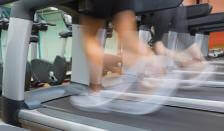How To Exercise Less With Faster Results
Want to get the quickest results possible from your workout? In today’s episode, Get-Fit Guy talks about two different studies that looked into “fast results”–one in the world of cardio, the other in the world of strength.

Sponsor: Visit GoDaddy.com to get your $1.99 .COM domain. Some limitations apply, see website for details.
But let’s say you’re less concerned about how little you can exercise, and instead want to get the fastest results possible from the exercise that you do – whether it is for 15, 30 or 90 minutes. In today’s episode, you’re going to learn about the fascinating results from two different studies that looked into just that – one in the world of cardio, the other in the world of strength.
How To Get Faster Cardio Results
The first study appeared in the Journal of Strength and Conditioning Research, and is entitled, “High-Intensity Interval Training Every Second Week Maintains VO2max in Soccer Players During Off-Season.” In this study, it was noted that reduced endurance training among soccer players during the off-season could have a negative effect on game performance during the competition season. So the researchers wanted to figure out the minimum amount of stress high intensity interval training (HIT) that the soccer players could “get away with” during the off-season, while still maintaining their maximum oxygen consuming capacity.
In the study, they looked 2 different frequencies of interval training sessions during a 6-week period: 1 HIT session every two weeks, or 1 HIT session every week. The HIT sessions were pretty standard protocols, and consisted of 5 bouts of 4 minutes of high-intensity (87–97% of maximum heart rate) treadmill running, with full recovery between each of the 4 minute bouts.
It turns out that doing the HIT session once a week didn’t get any better results than doing it once every 2 weeks! So when it comes to cardio, and maintaining peak cardio capacity, a single high intensity session once every two weeks will do the trick.
One of the best ways to do this is via very hard treadmill efforts that last about 4 minutes in duration. Just imagine how happy your co-worker who heads out at lunchtime every day to do a hard one hour run will feel when they hear this news!
 How To Get Faster Strength Results
How To Get Faster Strength Results
Now let’s move on to strength and muscle mass. The second study is one I read about in Medicina Sportiva,opens PDF file and is actually a review of most of the current evidence on muscular hypertrophy (muscle building) and various training protocols for hypertrophy.
The review had some very interesting findings, including:
- The duration of repetitions, or “time under tension” you spend during a weight training workout, makes no significant difference in muscle gains. But what ultimately matters is the amount of muscular tension you are subjected to during the workout. This means that, for example, 1 set of 5 very heavy repetitions is more effective than 5 sets of 10 light repetitions.
- Rest intervals have little-to-no effect on strength or muscle gains when controlling for exercise volume. What this means is that, ultimately, what matters when you walk out of the gym is how much “work” you managed to squeeze into the amount of time you have. If you can do 5 different exercises to failure within 15 minutes, and your friend does the same 5 different exercises but rests between each, reads some magazines, visits with friends and leaves after 60 minutes, you both get the same results – but you get an extra 45 minutes of free time!
- Endurance training won’t screw up muscular strength or limit hypertrophy, even if you do it during the workout, So you don’t have to visit the gym or do a workout twice a day (e.g. cardio at a different time than strength.) It’s perfectly OK to do it all at once, such as a treadmill run followed by a weight training workout.
But perhaps the most interesting part of the review were the observations that training through a limited range of motion might stimulate similar results to full range of motion exercise, and that short (approximately 3 week) periods of detraining in trained persons does not cause significant muscular atrophy–and might even stimulate greater hypertrophy and better muscle gains upon return to training!
So what this means is that if you lift heavily and intensely enough on a consistent basis, even if you’re only going through partial range of motion on your exercises, then you can get away with a few 3 week breaks during the year–with no strength or muscle loss!

If you have more questions about how to exercise less with faster results, you can leave your thoughts over at www.Facebook.com/GetFitGuy.
Photos of running on treadmill and couple at gym courtesy of Shutterstock.


 How To Get Faster Strength Results
How To Get Faster Strength Results



